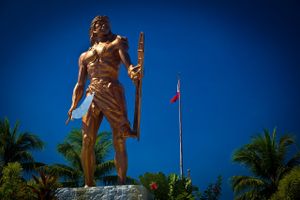Ferdinand Magellan is a name synonymous with exploration – straits, NASA space probes, baseball teams, and even a species of penguin have been named after the far-ranging Portuguese adventurer. Indeed, until the 18th century, the Pacific Ocean was often referred to as the Sea of Magellan.
But, despite his renown and celebrity staying power, Magellan himself never actually circumnavigated the globe. He was in fact killed on April 27th, 1521 on the Philippine island of Mactan, his trip abruptly cut short.
Magellan and his Spanish fleet had already arrived in the Philippines and been greeted amicably by Rajahs of neighboring islands, but when they arrived in Mactan, intent on continuing their forced religious conversion of the locals, Lapu-Lapu, Rajah of Mactan, defied orders to bend the knee and brought 1500 warriors down on the smaller Spanish-Portuguese force. While Magellan’s troops possessed greater firepower, the larger numbers of Lapu-Lapu’s fighters, armed with spears and poisoned arrows, overwhelmed the Europeans. Magellan suffered several wounds and the invaders retreated – one of the Portuguese’s fellow sailors wrote that, after the battle, “nothing of Magellan’s body survived”.
This marked the first instance of Filipino resistance to aggression from European powers, and it made Lapu-Lapu both a local legend and a national hero. On the shores of Mactan Island, a 20-meter bronze statue of Lapu-Lapu stands resolutely facing the ocean, seeming to dare the next would-be conqueror to wade ashore and get what is coming to him.
Of course, that invader would be wading in from what is now called Magellan Bay. And, if he peered just beyond the statue of Lapu-Lapu, the invader would be looking at an even bigger monument dedicated to – you guessed it – Magellan. What does a local guy have to do to get some respect around here?
